Literature Review: Employee Motivation's Effect on Job Satisfaction
VerifiedAdded on 2022/08/20
|16
|4437
|16
Literature Review
AI Summary
This literature review examines the multifaceted impact of employee motivation on job satisfaction within organizations. It highlights various factors influencing employee engagement and performance. The review emphasizes the importance of communication, reward systems, and recognition programs in fostering a motivated workforce. It also explores the role of fair remuneration, organizational culture, and leadership approaches, including transformational and servant leadership, in shaping employee satisfaction. The study also investigates the significance of workplace environment, health and safety policies, and the impact of discrimination and workplace conflicts on employee commitment and turnover. The review draws on multiple studies to analyze how these elements contribute to a positive work environment and enhance organizational productivity. It underscores the necessity for business leaders to prioritize employee needs to achieve sustainable growth and success.
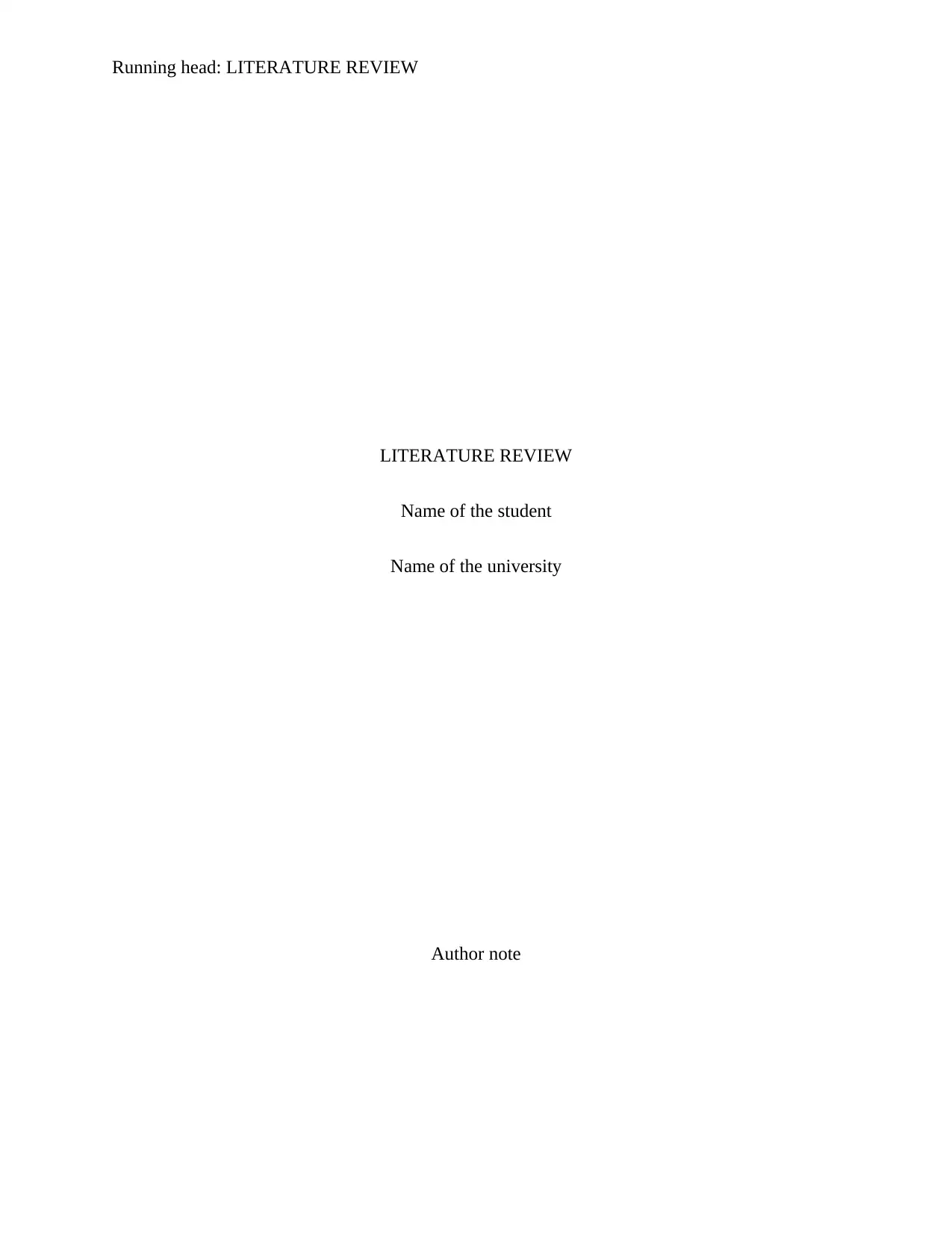
Running head: LITERATURE REVIEW
LITERATURE REVIEW
Name of the student
Name of the university
Author note
LITERATURE REVIEW
Name of the student
Name of the university
Author note
Paraphrase This Document
Need a fresh take? Get an instant paraphrase of this document with our AI Paraphraser
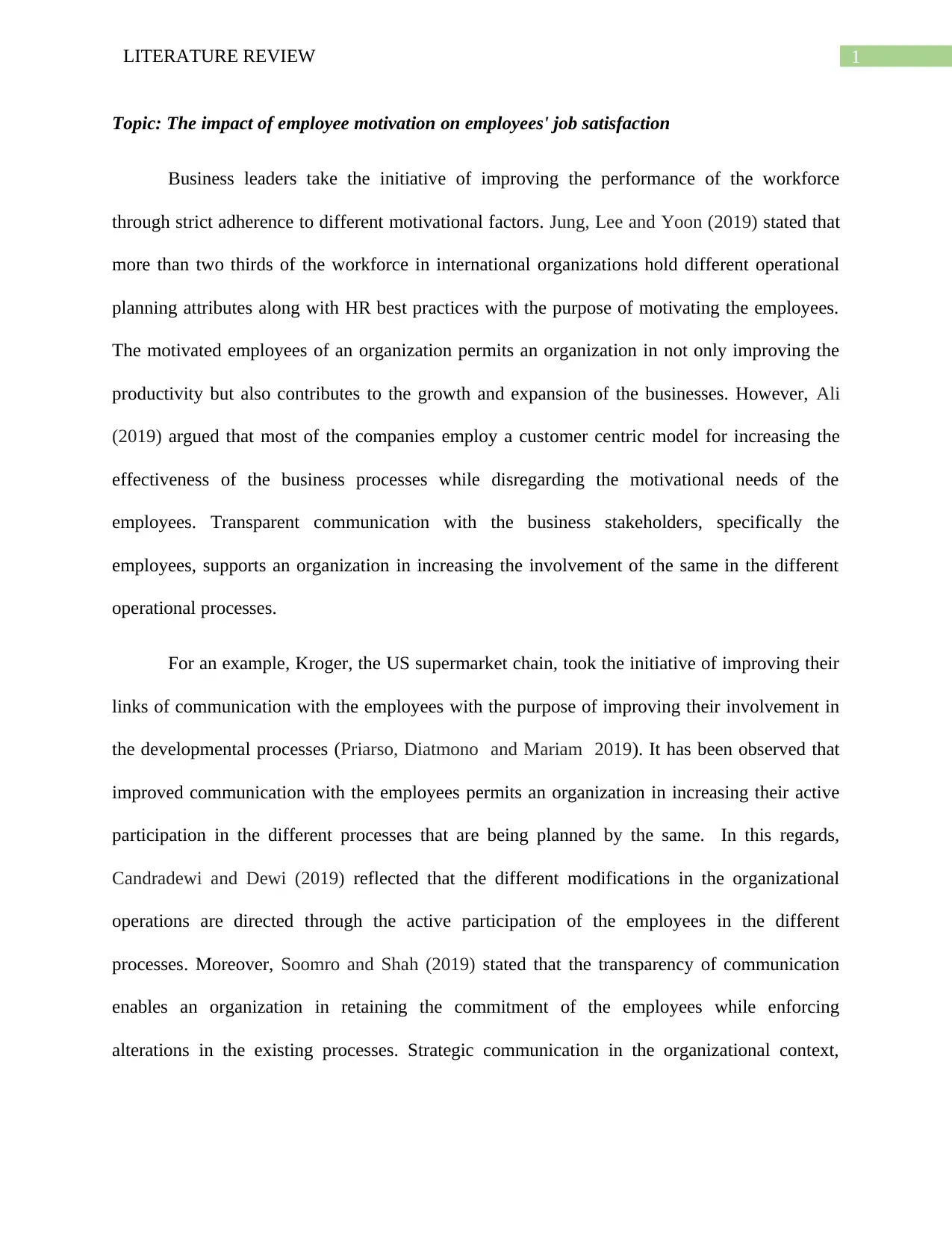
1LITERATURE REVIEW
Topic: The impact of employee motivation on employees' job satisfaction
Business leaders take the initiative of improving the performance of the workforce
through strict adherence to different motivational factors. Jung, Lee and Yoon (2019) stated that
more than two thirds of the workforce in international organizations hold different operational
planning attributes along with HR best practices with the purpose of motivating the employees.
The motivated employees of an organization permits an organization in not only improving the
productivity but also contributes to the growth and expansion of the businesses. However, Ali
(2019) argued that most of the companies employ a customer centric model for increasing the
effectiveness of the business processes while disregarding the motivational needs of the
employees. Transparent communication with the business stakeholders, specifically the
employees, supports an organization in increasing the involvement of the same in the different
operational processes.
For an example, Kroger, the US supermarket chain, took the initiative of improving their
links of communication with the employees with the purpose of improving their involvement in
the developmental processes (Priarso, Diatmono and Mariam 2019). It has been observed that
improved communication with the employees permits an organization in increasing their active
participation in the different processes that are being planned by the same. In this regards,
Candradewi and Dewi (2019) reflected that the different modifications in the organizational
operations are directed through the active participation of the employees in the different
processes. Moreover, Soomro and Shah (2019) stated that the transparency of communication
enables an organization in retaining the commitment of the employees while enforcing
alterations in the existing processes. Strategic communication in the organizational context,
Topic: The impact of employee motivation on employees' job satisfaction
Business leaders take the initiative of improving the performance of the workforce
through strict adherence to different motivational factors. Jung, Lee and Yoon (2019) stated that
more than two thirds of the workforce in international organizations hold different operational
planning attributes along with HR best practices with the purpose of motivating the employees.
The motivated employees of an organization permits an organization in not only improving the
productivity but also contributes to the growth and expansion of the businesses. However, Ali
(2019) argued that most of the companies employ a customer centric model for increasing the
effectiveness of the business processes while disregarding the motivational needs of the
employees. Transparent communication with the business stakeholders, specifically the
employees, supports an organization in increasing the involvement of the same in the different
operational processes.
For an example, Kroger, the US supermarket chain, took the initiative of improving their
links of communication with the employees with the purpose of improving their involvement in
the developmental processes (Priarso, Diatmono and Mariam 2019). It has been observed that
improved communication with the employees permits an organization in increasing their active
participation in the different processes that are being planned by the same. In this regards,
Candradewi and Dewi (2019) reflected that the different modifications in the organizational
operations are directed through the active participation of the employees in the different
processes. Moreover, Soomro and Shah (2019) stated that the transparency of communication
enables an organization in retaining the commitment of the employees while enforcing
alterations in the existing processes. Strategic communication in the organizational context,
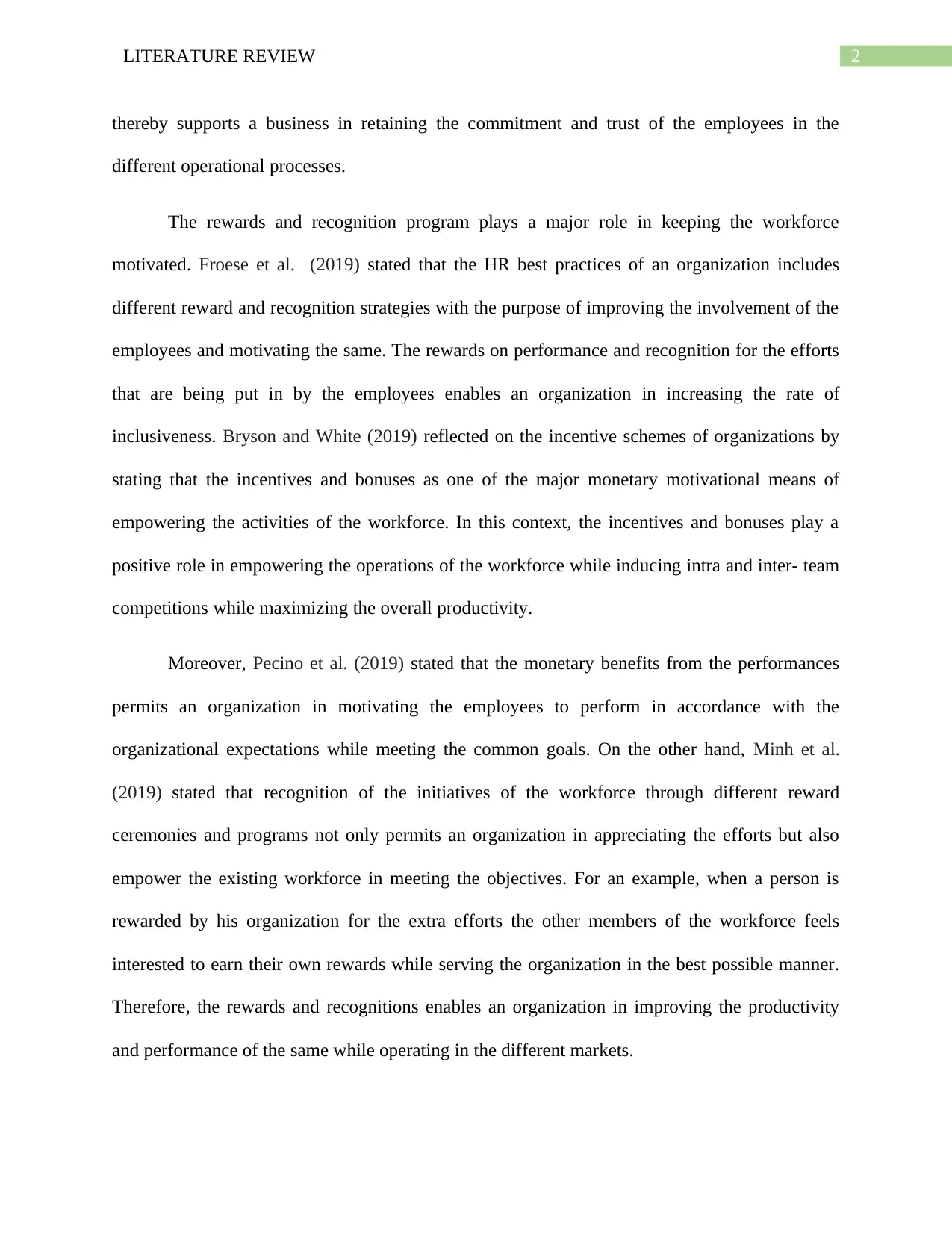
2LITERATURE REVIEW
thereby supports a business in retaining the commitment and trust of the employees in the
different operational processes.
The rewards and recognition program plays a major role in keeping the workforce
motivated. Froese et al. (2019) stated that the HR best practices of an organization includes
different reward and recognition strategies with the purpose of improving the involvement of the
employees and motivating the same. The rewards on performance and recognition for the efforts
that are being put in by the employees enables an organization in increasing the rate of
inclusiveness. Bryson and White (2019) reflected on the incentive schemes of organizations by
stating that the incentives and bonuses as one of the major monetary motivational means of
empowering the activities of the workforce. In this context, the incentives and bonuses play a
positive role in empowering the operations of the workforce while inducing intra and inter- team
competitions while maximizing the overall productivity.
Moreover, Pecino et al. (2019) stated that the monetary benefits from the performances
permits an organization in motivating the employees to perform in accordance with the
organizational expectations while meeting the common goals. On the other hand, Minh et al.
(2019) stated that recognition of the initiatives of the workforce through different reward
ceremonies and programs not only permits an organization in appreciating the efforts but also
empower the existing workforce in meeting the objectives. For an example, when a person is
rewarded by his organization for the extra efforts the other members of the workforce feels
interested to earn their own rewards while serving the organization in the best possible manner.
Therefore, the rewards and recognitions enables an organization in improving the productivity
and performance of the same while operating in the different markets.
thereby supports a business in retaining the commitment and trust of the employees in the
different operational processes.
The rewards and recognition program plays a major role in keeping the workforce
motivated. Froese et al. (2019) stated that the HR best practices of an organization includes
different reward and recognition strategies with the purpose of improving the involvement of the
employees and motivating the same. The rewards on performance and recognition for the efforts
that are being put in by the employees enables an organization in increasing the rate of
inclusiveness. Bryson and White (2019) reflected on the incentive schemes of organizations by
stating that the incentives and bonuses as one of the major monetary motivational means of
empowering the activities of the workforce. In this context, the incentives and bonuses play a
positive role in empowering the operations of the workforce while inducing intra and inter- team
competitions while maximizing the overall productivity.
Moreover, Pecino et al. (2019) stated that the monetary benefits from the performances
permits an organization in motivating the employees to perform in accordance with the
organizational expectations while meeting the common goals. On the other hand, Minh et al.
(2019) stated that recognition of the initiatives of the workforce through different reward
ceremonies and programs not only permits an organization in appreciating the efforts but also
empower the existing workforce in meeting the objectives. For an example, when a person is
rewarded by his organization for the extra efforts the other members of the workforce feels
interested to earn their own rewards while serving the organization in the best possible manner.
Therefore, the rewards and recognitions enables an organization in improving the productivity
and performance of the same while operating in the different markets.
⊘ This is a preview!⊘
Do you want full access?
Subscribe today to unlock all pages.

Trusted by 1+ million students worldwide
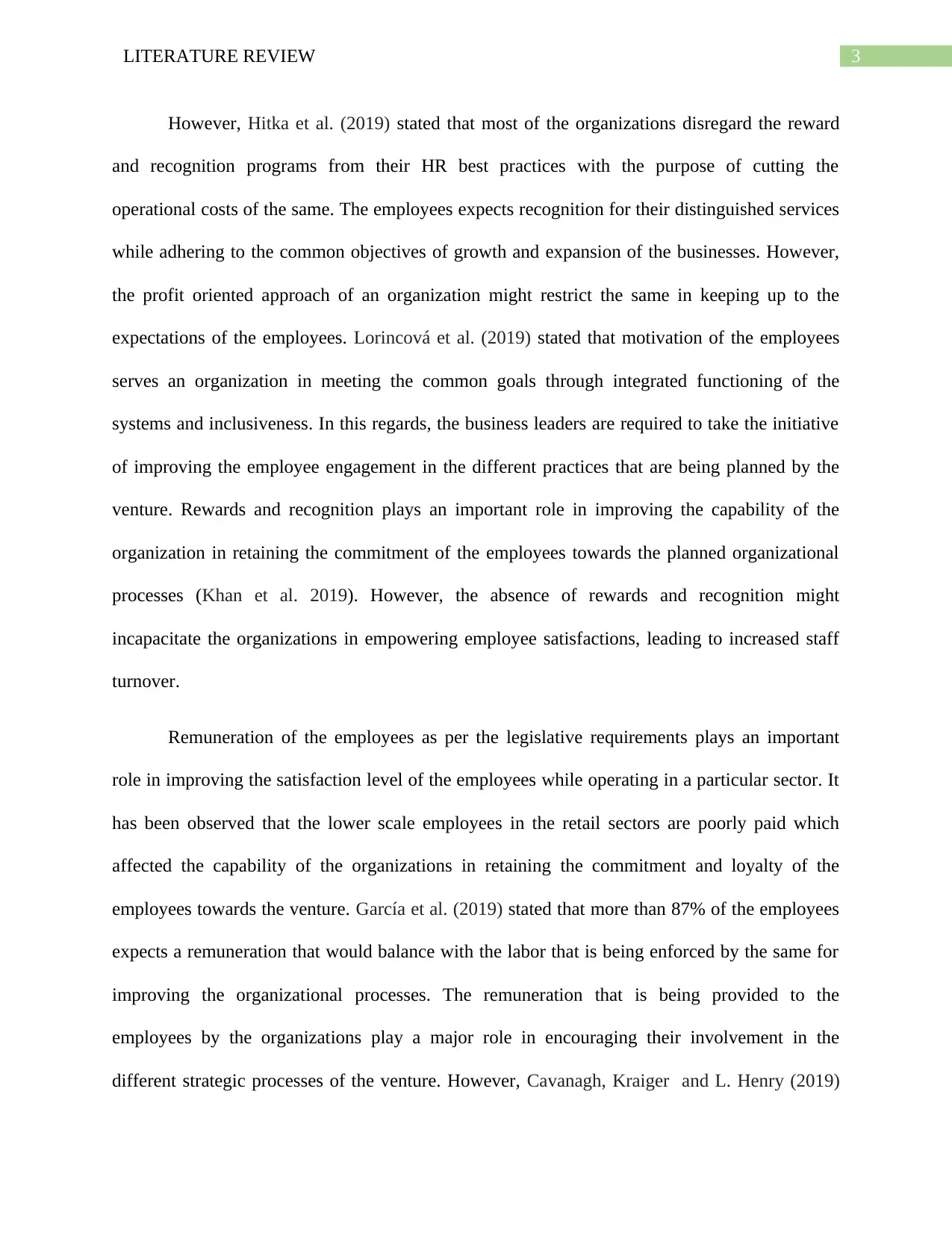
3LITERATURE REVIEW
However, Hitka et al. (2019) stated that most of the organizations disregard the reward
and recognition programs from their HR best practices with the purpose of cutting the
operational costs of the same. The employees expects recognition for their distinguished services
while adhering to the common objectives of growth and expansion of the businesses. However,
the profit oriented approach of an organization might restrict the same in keeping up to the
expectations of the employees. Lorincová et al. (2019) stated that motivation of the employees
serves an organization in meeting the common goals through integrated functioning of the
systems and inclusiveness. In this regards, the business leaders are required to take the initiative
of improving the employee engagement in the different practices that are being planned by the
venture. Rewards and recognition plays an important role in improving the capability of the
organization in retaining the commitment of the employees towards the planned organizational
processes (Khan et al. 2019). However, the absence of rewards and recognition might
incapacitate the organizations in empowering employee satisfactions, leading to increased staff
turnover.
Remuneration of the employees as per the legislative requirements plays an important
role in improving the satisfaction level of the employees while operating in a particular sector. It
has been observed that the lower scale employees in the retail sectors are poorly paid which
affected the capability of the organizations in retaining the commitment and loyalty of the
employees towards the venture. García et al. (2019) stated that more than 87% of the employees
expects a remuneration that would balance with the labor that is being enforced by the same for
improving the organizational processes. The remuneration that is being provided to the
employees by the organizations play a major role in encouraging their involvement in the
different strategic processes of the venture. However, Cavanagh, Kraiger and L. Henry (2019)
However, Hitka et al. (2019) stated that most of the organizations disregard the reward
and recognition programs from their HR best practices with the purpose of cutting the
operational costs of the same. The employees expects recognition for their distinguished services
while adhering to the common objectives of growth and expansion of the businesses. However,
the profit oriented approach of an organization might restrict the same in keeping up to the
expectations of the employees. Lorincová et al. (2019) stated that motivation of the employees
serves an organization in meeting the common goals through integrated functioning of the
systems and inclusiveness. In this regards, the business leaders are required to take the initiative
of improving the employee engagement in the different practices that are being planned by the
venture. Rewards and recognition plays an important role in improving the capability of the
organization in retaining the commitment of the employees towards the planned organizational
processes (Khan et al. 2019). However, the absence of rewards and recognition might
incapacitate the organizations in empowering employee satisfactions, leading to increased staff
turnover.
Remuneration of the employees as per the legislative requirements plays an important
role in improving the satisfaction level of the employees while operating in a particular sector. It
has been observed that the lower scale employees in the retail sectors are poorly paid which
affected the capability of the organizations in retaining the commitment and loyalty of the
employees towards the venture. García et al. (2019) stated that more than 87% of the employees
expects a remuneration that would balance with the labor that is being enforced by the same for
improving the organizational processes. The remuneration that is being provided to the
employees by the organizations play a major role in encouraging their involvement in the
different strategic processes of the venture. However, Cavanagh, Kraiger and L. Henry (2019)
Paraphrase This Document
Need a fresh take? Get an instant paraphrase of this document with our AI Paraphraser
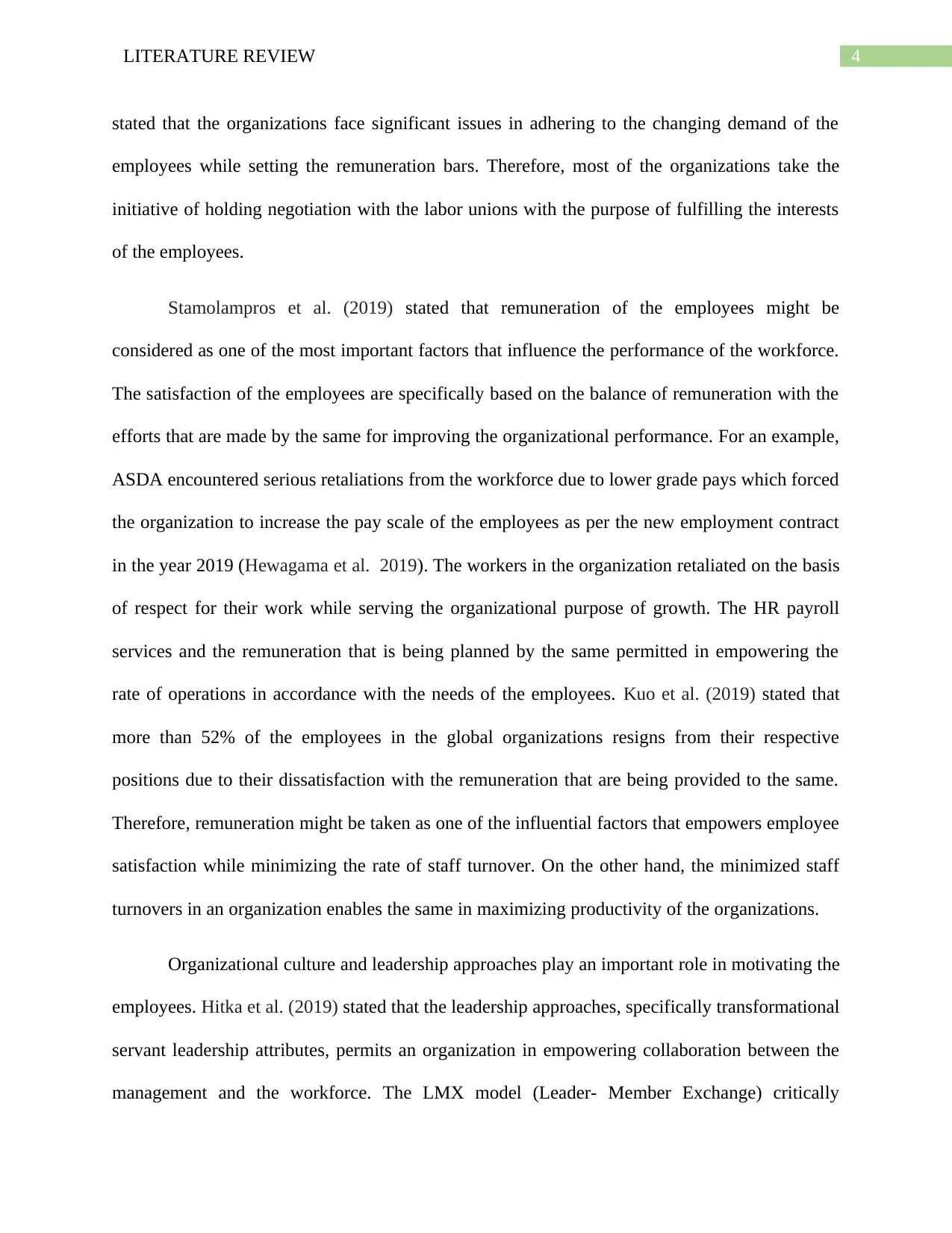
4LITERATURE REVIEW
stated that the organizations face significant issues in adhering to the changing demand of the
employees while setting the remuneration bars. Therefore, most of the organizations take the
initiative of holding negotiation with the labor unions with the purpose of fulfilling the interests
of the employees.
Stamolampros et al. (2019) stated that remuneration of the employees might be
considered as one of the most important factors that influence the performance of the workforce.
The satisfaction of the employees are specifically based on the balance of remuneration with the
efforts that are made by the same for improving the organizational performance. For an example,
ASDA encountered serious retaliations from the workforce due to lower grade pays which forced
the organization to increase the pay scale of the employees as per the new employment contract
in the year 2019 (Hewagama et al. 2019). The workers in the organization retaliated on the basis
of respect for their work while serving the organizational purpose of growth. The HR payroll
services and the remuneration that is being planned by the same permitted in empowering the
rate of operations in accordance with the needs of the employees. Kuo et al. (2019) stated that
more than 52% of the employees in the global organizations resigns from their respective
positions due to their dissatisfaction with the remuneration that are being provided to the same.
Therefore, remuneration might be taken as one of the influential factors that empowers employee
satisfaction while minimizing the rate of staff turnover. On the other hand, the minimized staff
turnovers in an organization enables the same in maximizing productivity of the organizations.
Organizational culture and leadership approaches play an important role in motivating the
employees. Hitka et al. (2019) stated that the leadership approaches, specifically transformational
servant leadership attributes, permits an organization in empowering collaboration between the
management and the workforce. The LMX model (Leader- Member Exchange) critically
stated that the organizations face significant issues in adhering to the changing demand of the
employees while setting the remuneration bars. Therefore, most of the organizations take the
initiative of holding negotiation with the labor unions with the purpose of fulfilling the interests
of the employees.
Stamolampros et al. (2019) stated that remuneration of the employees might be
considered as one of the most important factors that influence the performance of the workforce.
The satisfaction of the employees are specifically based on the balance of remuneration with the
efforts that are made by the same for improving the organizational performance. For an example,
ASDA encountered serious retaliations from the workforce due to lower grade pays which forced
the organization to increase the pay scale of the employees as per the new employment contract
in the year 2019 (Hewagama et al. 2019). The workers in the organization retaliated on the basis
of respect for their work while serving the organizational purpose of growth. The HR payroll
services and the remuneration that is being planned by the same permitted in empowering the
rate of operations in accordance with the needs of the employees. Kuo et al. (2019) stated that
more than 52% of the employees in the global organizations resigns from their respective
positions due to their dissatisfaction with the remuneration that are being provided to the same.
Therefore, remuneration might be taken as one of the influential factors that empowers employee
satisfaction while minimizing the rate of staff turnover. On the other hand, the minimized staff
turnovers in an organization enables the same in maximizing productivity of the organizations.
Organizational culture and leadership approaches play an important role in motivating the
employees. Hitka et al. (2019) stated that the leadership approaches, specifically transformational
servant leadership attributes, permits an organization in empowering collaboration between the
management and the workforce. The LMX model (Leader- Member Exchange) critically
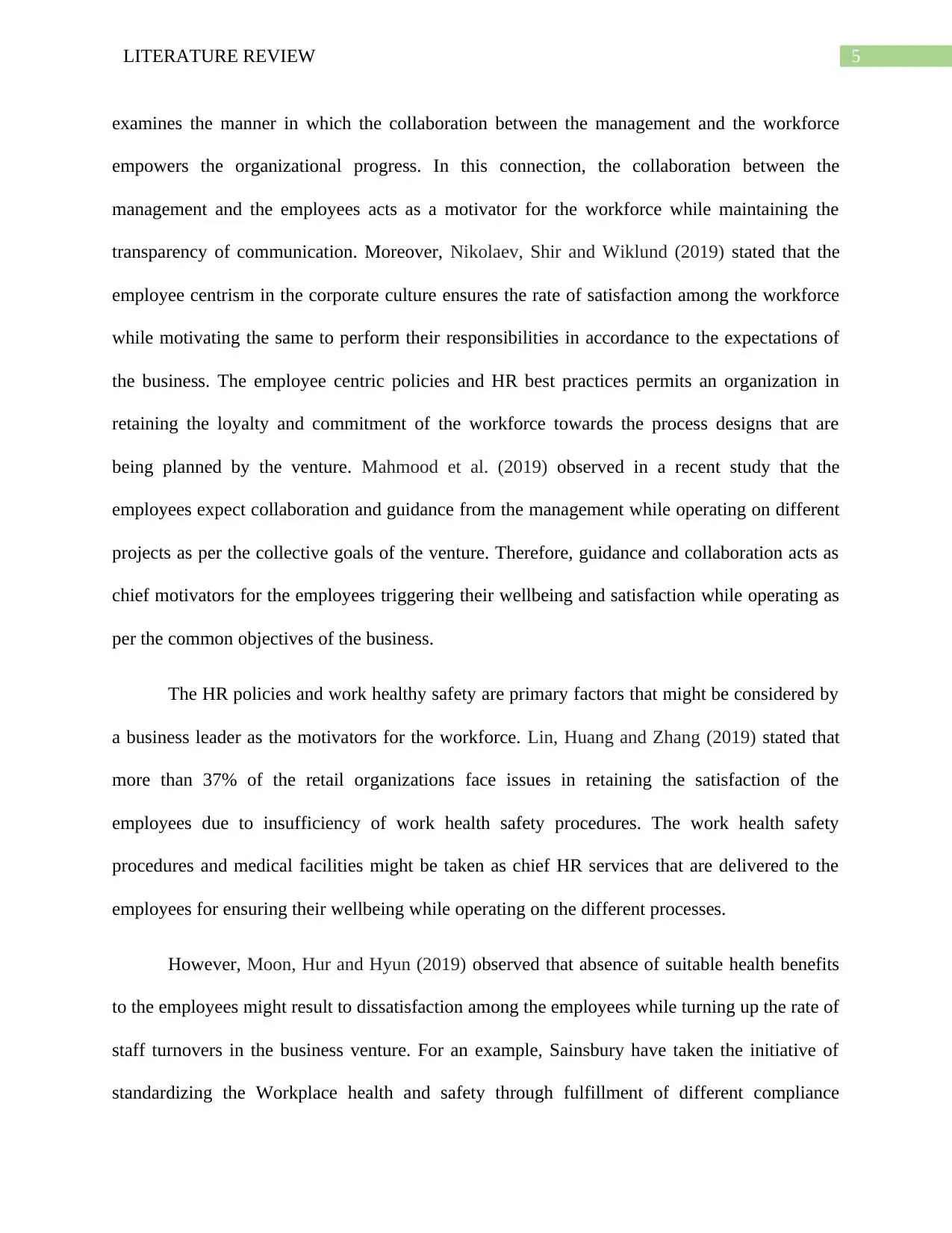
5LITERATURE REVIEW
examines the manner in which the collaboration between the management and the workforce
empowers the organizational progress. In this connection, the collaboration between the
management and the employees acts as a motivator for the workforce while maintaining the
transparency of communication. Moreover, Nikolaev, Shir and Wiklund (2019) stated that the
employee centrism in the corporate culture ensures the rate of satisfaction among the workforce
while motivating the same to perform their responsibilities in accordance to the expectations of
the business. The employee centric policies and HR best practices permits an organization in
retaining the loyalty and commitment of the workforce towards the process designs that are
being planned by the venture. Mahmood et al. (2019) observed in a recent study that the
employees expect collaboration and guidance from the management while operating on different
projects as per the collective goals of the venture. Therefore, guidance and collaboration acts as
chief motivators for the employees triggering their wellbeing and satisfaction while operating as
per the common objectives of the business.
The HR policies and work healthy safety are primary factors that might be considered by
a business leader as the motivators for the workforce. Lin, Huang and Zhang (2019) stated that
more than 37% of the retail organizations face issues in retaining the satisfaction of the
employees due to insufficiency of work health safety procedures. The work health safety
procedures and medical facilities might be taken as chief HR services that are delivered to the
employees for ensuring their wellbeing while operating on the different processes.
However, Moon, Hur and Hyun (2019) observed that absence of suitable health benefits
to the employees might result to dissatisfaction among the employees while turning up the rate of
staff turnovers in the business venture. For an example, Sainsbury have taken the initiative of
standardizing the Workplace health and safety through fulfillment of different compliance
examines the manner in which the collaboration between the management and the workforce
empowers the organizational progress. In this connection, the collaboration between the
management and the employees acts as a motivator for the workforce while maintaining the
transparency of communication. Moreover, Nikolaev, Shir and Wiklund (2019) stated that the
employee centrism in the corporate culture ensures the rate of satisfaction among the workforce
while motivating the same to perform their responsibilities in accordance to the expectations of
the business. The employee centric policies and HR best practices permits an organization in
retaining the loyalty and commitment of the workforce towards the process designs that are
being planned by the venture. Mahmood et al. (2019) observed in a recent study that the
employees expect collaboration and guidance from the management while operating on different
projects as per the collective goals of the venture. Therefore, guidance and collaboration acts as
chief motivators for the employees triggering their wellbeing and satisfaction while operating as
per the common objectives of the business.
The HR policies and work healthy safety are primary factors that might be considered by
a business leader as the motivators for the workforce. Lin, Huang and Zhang (2019) stated that
more than 37% of the retail organizations face issues in retaining the satisfaction of the
employees due to insufficiency of work health safety procedures. The work health safety
procedures and medical facilities might be taken as chief HR services that are delivered to the
employees for ensuring their wellbeing while operating on the different processes.
However, Moon, Hur and Hyun (2019) observed that absence of suitable health benefits
to the employees might result to dissatisfaction among the employees while turning up the rate of
staff turnovers in the business venture. For an example, Sainsbury have taken the initiative of
standardizing the Workplace health and safety through fulfillment of different compliance
⊘ This is a preview!⊘
Do you want full access?
Subscribe today to unlock all pages.

Trusted by 1+ million students worldwide
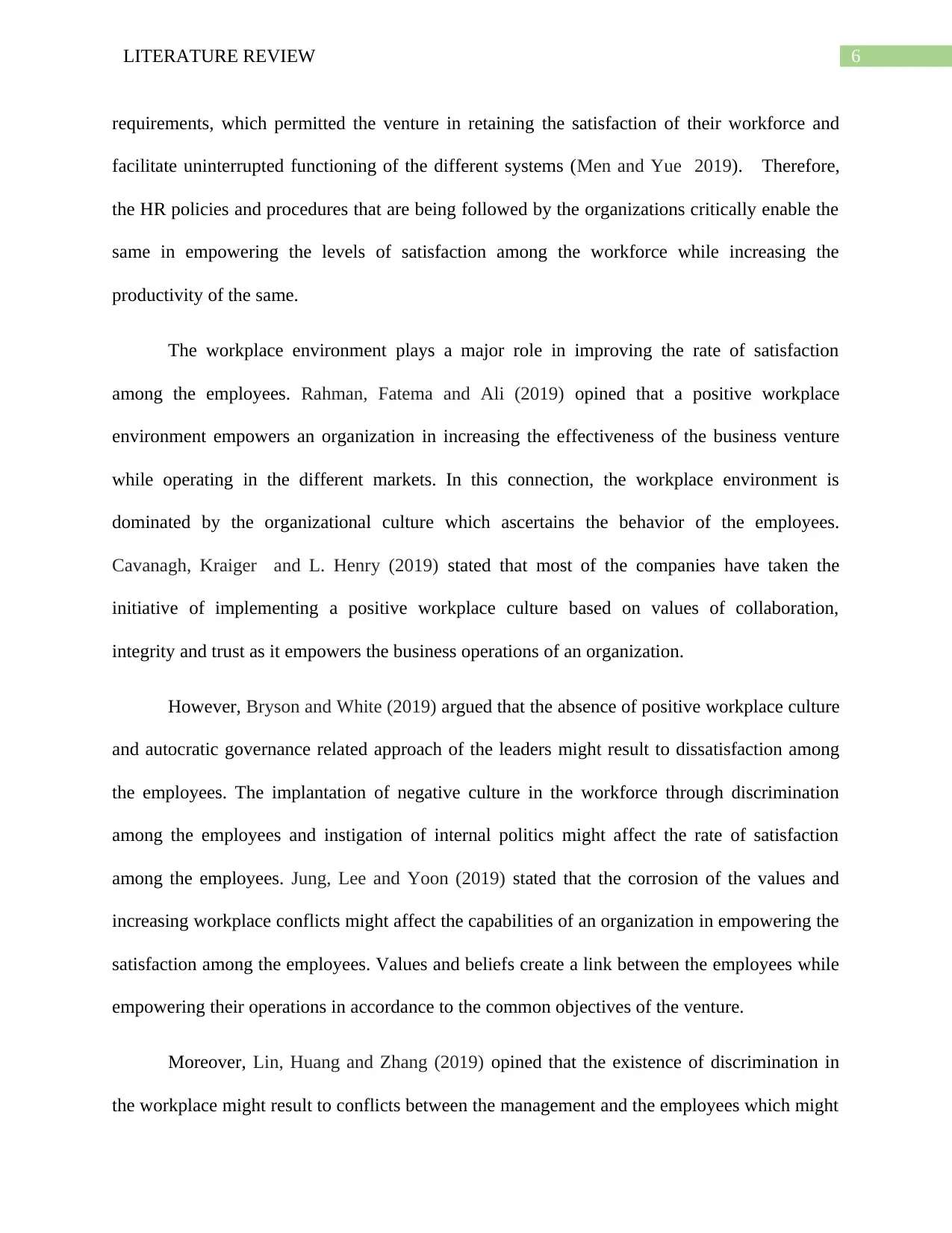
6LITERATURE REVIEW
requirements, which permitted the venture in retaining the satisfaction of their workforce and
facilitate uninterrupted functioning of the different systems (Men and Yue 2019). Therefore,
the HR policies and procedures that are being followed by the organizations critically enable the
same in empowering the levels of satisfaction among the workforce while increasing the
productivity of the same.
The workplace environment plays a major role in improving the rate of satisfaction
among the employees. Rahman, Fatema and Ali (2019) opined that a positive workplace
environment empowers an organization in increasing the effectiveness of the business venture
while operating in the different markets. In this connection, the workplace environment is
dominated by the organizational culture which ascertains the behavior of the employees.
Cavanagh, Kraiger and L. Henry (2019) stated that most of the companies have taken the
initiative of implementing a positive workplace culture based on values of collaboration,
integrity and trust as it empowers the business operations of an organization.
However, Bryson and White (2019) argued that the absence of positive workplace culture
and autocratic governance related approach of the leaders might result to dissatisfaction among
the employees. The implantation of negative culture in the workforce through discrimination
among the employees and instigation of internal politics might affect the rate of satisfaction
among the employees. Jung, Lee and Yoon (2019) stated that the corrosion of the values and
increasing workplace conflicts might affect the capabilities of an organization in empowering the
satisfaction among the employees. Values and beliefs create a link between the employees while
empowering their operations in accordance to the common objectives of the venture.
Moreover, Lin, Huang and Zhang (2019) opined that the existence of discrimination in
the workplace might result to conflicts between the management and the employees which might
requirements, which permitted the venture in retaining the satisfaction of their workforce and
facilitate uninterrupted functioning of the different systems (Men and Yue 2019). Therefore,
the HR policies and procedures that are being followed by the organizations critically enable the
same in empowering the levels of satisfaction among the workforce while increasing the
productivity of the same.
The workplace environment plays a major role in improving the rate of satisfaction
among the employees. Rahman, Fatema and Ali (2019) opined that a positive workplace
environment empowers an organization in increasing the effectiveness of the business venture
while operating in the different markets. In this connection, the workplace environment is
dominated by the organizational culture which ascertains the behavior of the employees.
Cavanagh, Kraiger and L. Henry (2019) stated that most of the companies have taken the
initiative of implementing a positive workplace culture based on values of collaboration,
integrity and trust as it empowers the business operations of an organization.
However, Bryson and White (2019) argued that the absence of positive workplace culture
and autocratic governance related approach of the leaders might result to dissatisfaction among
the employees. The implantation of negative culture in the workforce through discrimination
among the employees and instigation of internal politics might affect the rate of satisfaction
among the employees. Jung, Lee and Yoon (2019) stated that the corrosion of the values and
increasing workplace conflicts might affect the capabilities of an organization in empowering the
satisfaction among the employees. Values and beliefs create a link between the employees while
empowering their operations in accordance to the common objectives of the venture.
Moreover, Lin, Huang and Zhang (2019) opined that the existence of discrimination in
the workplace might result to conflicts between the management and the employees which might
Paraphrase This Document
Need a fresh take? Get an instant paraphrase of this document with our AI Paraphraser
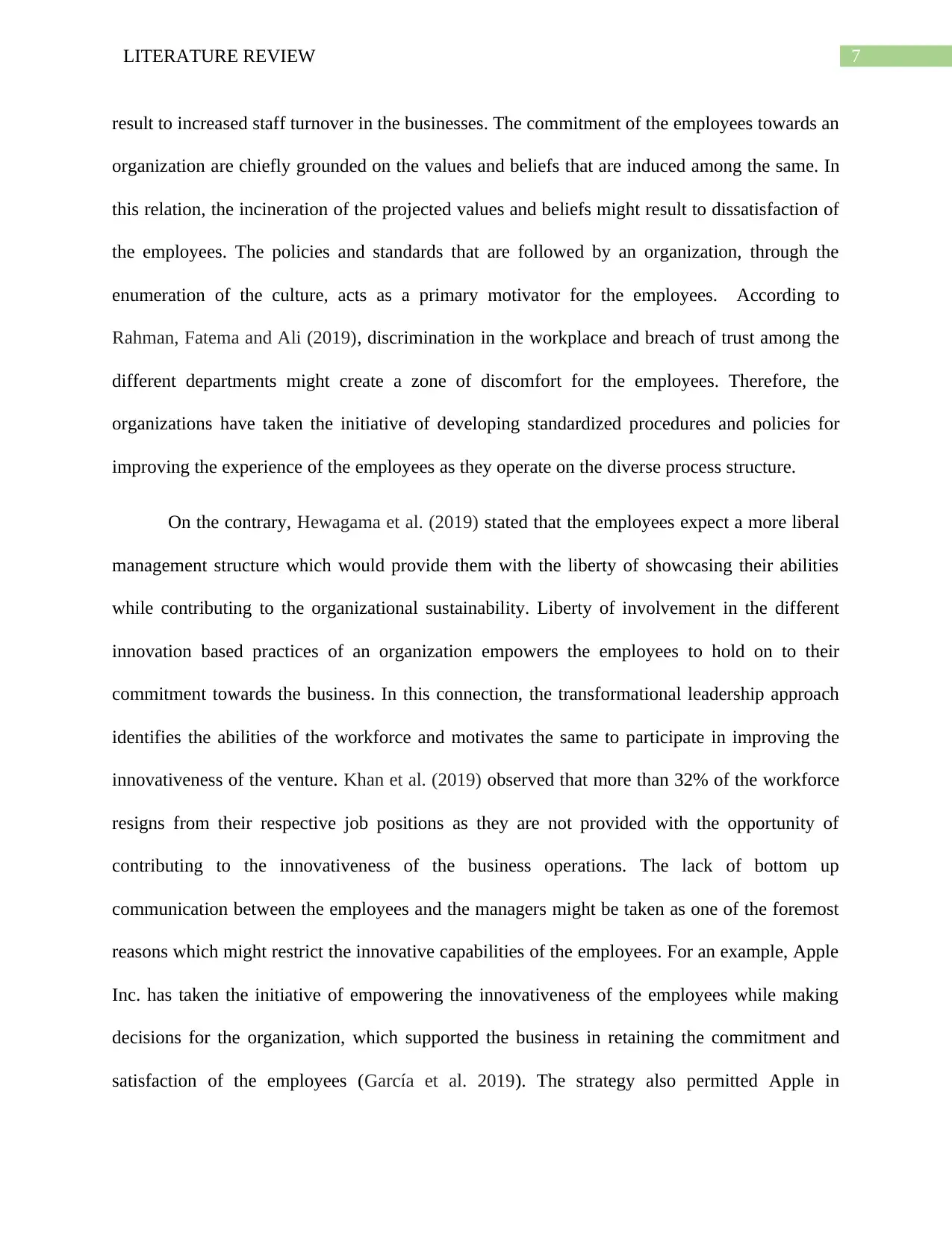
7LITERATURE REVIEW
result to increased staff turnover in the businesses. The commitment of the employees towards an
organization are chiefly grounded on the values and beliefs that are induced among the same. In
this relation, the incineration of the projected values and beliefs might result to dissatisfaction of
the employees. The policies and standards that are followed by an organization, through the
enumeration of the culture, acts as a primary motivator for the employees. According to
Rahman, Fatema and Ali (2019), discrimination in the workplace and breach of trust among the
different departments might create a zone of discomfort for the employees. Therefore, the
organizations have taken the initiative of developing standardized procedures and policies for
improving the experience of the employees as they operate on the diverse process structure.
On the contrary, Hewagama et al. (2019) stated that the employees expect a more liberal
management structure which would provide them with the liberty of showcasing their abilities
while contributing to the organizational sustainability. Liberty of involvement in the different
innovation based practices of an organization empowers the employees to hold on to their
commitment towards the business. In this connection, the transformational leadership approach
identifies the abilities of the workforce and motivates the same to participate in improving the
innovativeness of the venture. Khan et al. (2019) observed that more than 32% of the workforce
resigns from their respective job positions as they are not provided with the opportunity of
contributing to the innovativeness of the business operations. The lack of bottom up
communication between the employees and the managers might be taken as one of the foremost
reasons which might restrict the innovative capabilities of the employees. For an example, Apple
Inc. has taken the initiative of empowering the innovativeness of the employees while making
decisions for the organization, which supported the business in retaining the commitment and
satisfaction of the employees (García et al. 2019). The strategy also permitted Apple in
result to increased staff turnover in the businesses. The commitment of the employees towards an
organization are chiefly grounded on the values and beliefs that are induced among the same. In
this relation, the incineration of the projected values and beliefs might result to dissatisfaction of
the employees. The policies and standards that are followed by an organization, through the
enumeration of the culture, acts as a primary motivator for the employees. According to
Rahman, Fatema and Ali (2019), discrimination in the workplace and breach of trust among the
different departments might create a zone of discomfort for the employees. Therefore, the
organizations have taken the initiative of developing standardized procedures and policies for
improving the experience of the employees as they operate on the diverse process structure.
On the contrary, Hewagama et al. (2019) stated that the employees expect a more liberal
management structure which would provide them with the liberty of showcasing their abilities
while contributing to the organizational sustainability. Liberty of involvement in the different
innovation based practices of an organization empowers the employees to hold on to their
commitment towards the business. In this connection, the transformational leadership approach
identifies the abilities of the workforce and motivates the same to participate in improving the
innovativeness of the venture. Khan et al. (2019) observed that more than 32% of the workforce
resigns from their respective job positions as they are not provided with the opportunity of
contributing to the innovativeness of the business operations. The lack of bottom up
communication between the employees and the managers might be taken as one of the foremost
reasons which might restrict the innovative capabilities of the employees. For an example, Apple
Inc. has taken the initiative of empowering the innovativeness of the employees while making
decisions for the organization, which supported the business in retaining the commitment and
satisfaction of the employees (García et al. 2019). The strategy also permitted Apple in
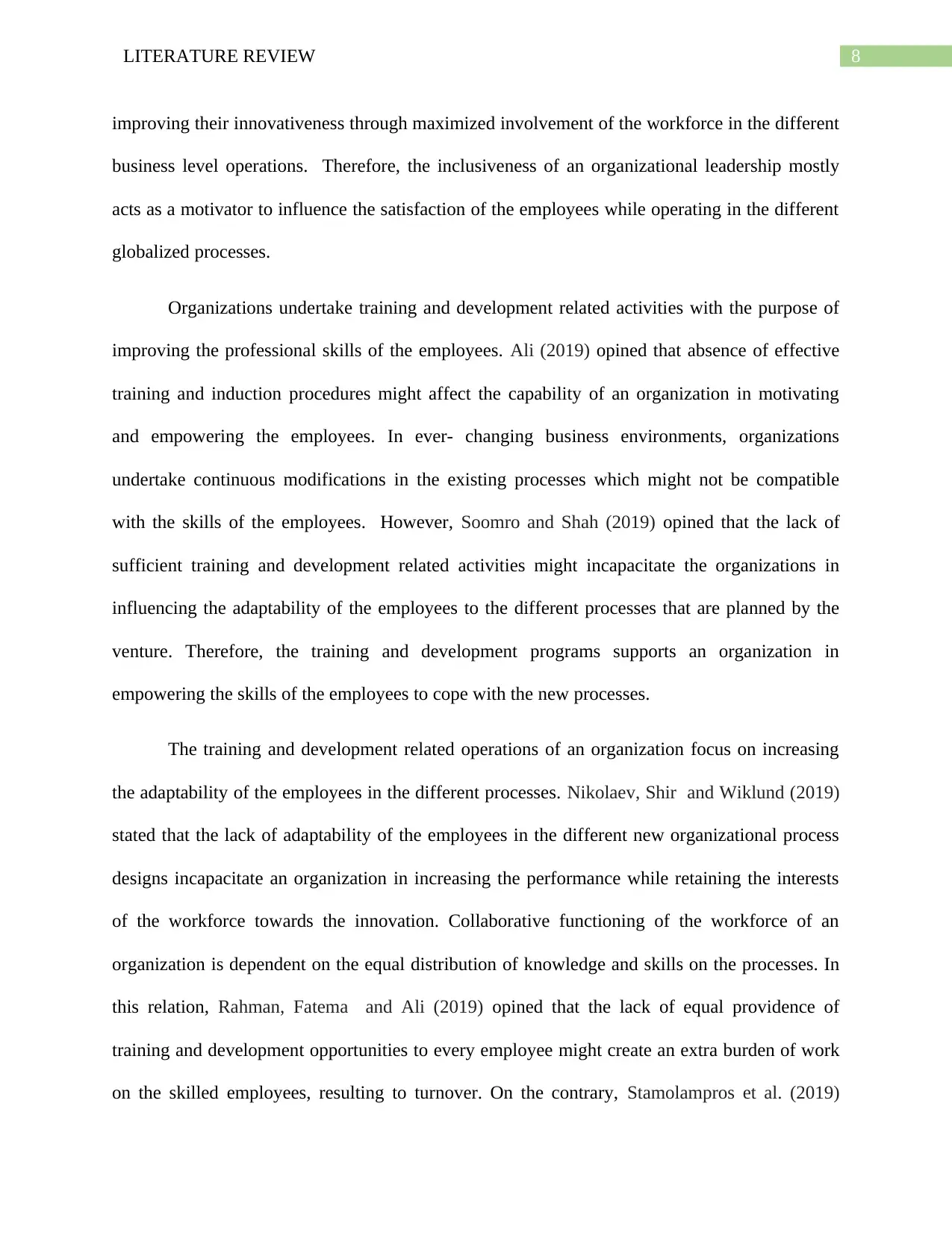
8LITERATURE REVIEW
improving their innovativeness through maximized involvement of the workforce in the different
business level operations. Therefore, the inclusiveness of an organizational leadership mostly
acts as a motivator to influence the satisfaction of the employees while operating in the different
globalized processes.
Organizations undertake training and development related activities with the purpose of
improving the professional skills of the employees. Ali (2019) opined that absence of effective
training and induction procedures might affect the capability of an organization in motivating
and empowering the employees. In ever- changing business environments, organizations
undertake continuous modifications in the existing processes which might not be compatible
with the skills of the employees. However, Soomro and Shah (2019) opined that the lack of
sufficient training and development related activities might incapacitate the organizations in
influencing the adaptability of the employees to the different processes that are planned by the
venture. Therefore, the training and development programs supports an organization in
empowering the skills of the employees to cope with the new processes.
The training and development related operations of an organization focus on increasing
the adaptability of the employees in the different processes. Nikolaev, Shir and Wiklund (2019)
stated that the lack of adaptability of the employees in the different new organizational process
designs incapacitate an organization in increasing the performance while retaining the interests
of the workforce towards the innovation. Collaborative functioning of the workforce of an
organization is dependent on the equal distribution of knowledge and skills on the processes. In
this relation, Rahman, Fatema and Ali (2019) opined that the lack of equal providence of
training and development opportunities to every employee might create an extra burden of work
on the skilled employees, resulting to turnover. On the contrary, Stamolampros et al. (2019)
improving their innovativeness through maximized involvement of the workforce in the different
business level operations. Therefore, the inclusiveness of an organizational leadership mostly
acts as a motivator to influence the satisfaction of the employees while operating in the different
globalized processes.
Organizations undertake training and development related activities with the purpose of
improving the professional skills of the employees. Ali (2019) opined that absence of effective
training and induction procedures might affect the capability of an organization in motivating
and empowering the employees. In ever- changing business environments, organizations
undertake continuous modifications in the existing processes which might not be compatible
with the skills of the employees. However, Soomro and Shah (2019) opined that the lack of
sufficient training and development related activities might incapacitate the organizations in
influencing the adaptability of the employees to the different processes that are planned by the
venture. Therefore, the training and development programs supports an organization in
empowering the skills of the employees to cope with the new processes.
The training and development related operations of an organization focus on increasing
the adaptability of the employees in the different processes. Nikolaev, Shir and Wiklund (2019)
stated that the lack of adaptability of the employees in the different new organizational process
designs incapacitate an organization in increasing the performance while retaining the interests
of the workforce towards the innovation. Collaborative functioning of the workforce of an
organization is dependent on the equal distribution of knowledge and skills on the processes. In
this relation, Rahman, Fatema and Ali (2019) opined that the lack of equal providence of
training and development opportunities to every employee might create an extra burden of work
on the skilled employees, resulting to turnover. On the contrary, Stamolampros et al. (2019)
⊘ This is a preview!⊘
Do you want full access?
Subscribe today to unlock all pages.

Trusted by 1+ million students worldwide
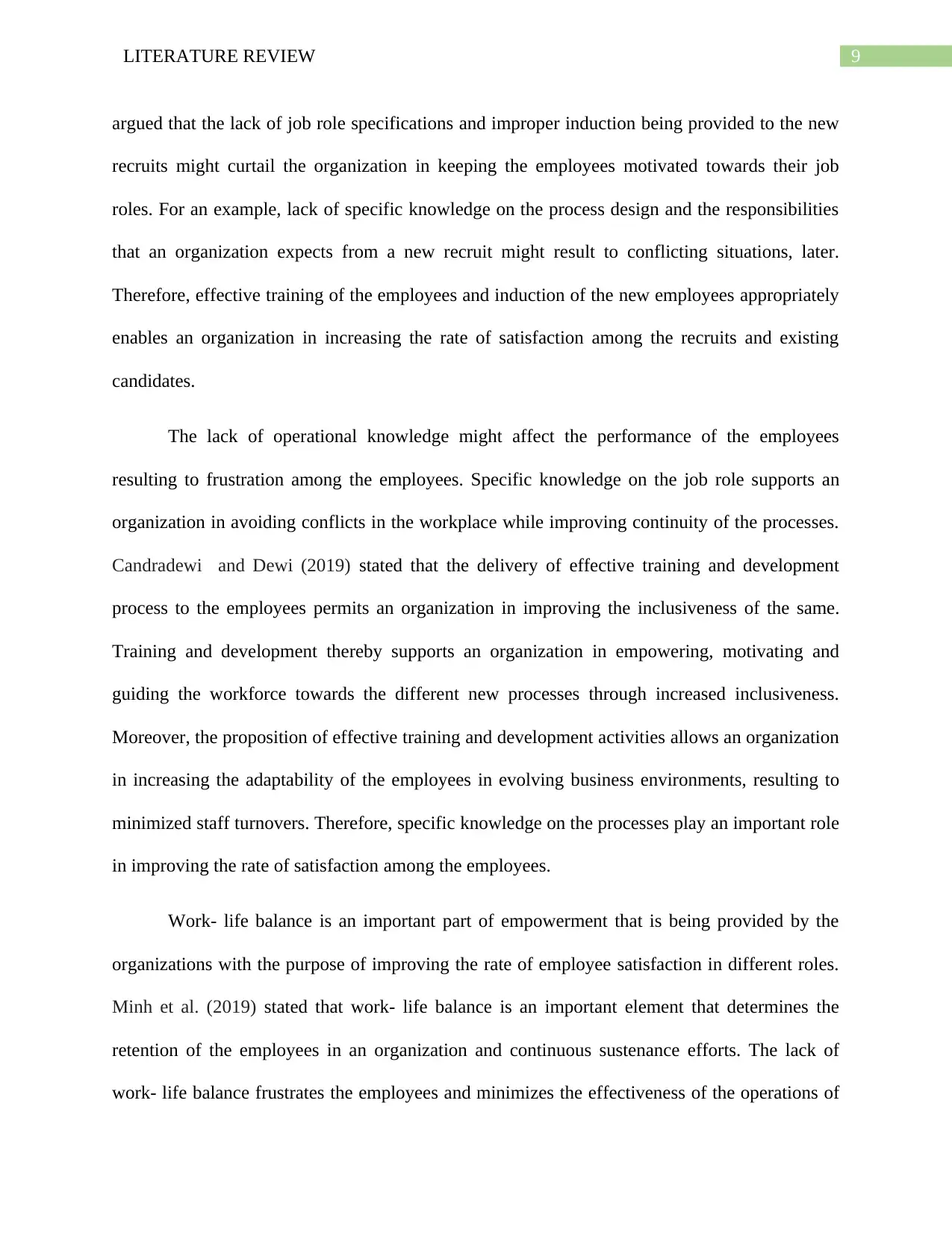
9LITERATURE REVIEW
argued that the lack of job role specifications and improper induction being provided to the new
recruits might curtail the organization in keeping the employees motivated towards their job
roles. For an example, lack of specific knowledge on the process design and the responsibilities
that an organization expects from a new recruit might result to conflicting situations, later.
Therefore, effective training of the employees and induction of the new employees appropriately
enables an organization in increasing the rate of satisfaction among the recruits and existing
candidates.
The lack of operational knowledge might affect the performance of the employees
resulting to frustration among the employees. Specific knowledge on the job role supports an
organization in avoiding conflicts in the workplace while improving continuity of the processes.
Candradewi and Dewi (2019) stated that the delivery of effective training and development
process to the employees permits an organization in improving the inclusiveness of the same.
Training and development thereby supports an organization in empowering, motivating and
guiding the workforce towards the different new processes through increased inclusiveness.
Moreover, the proposition of effective training and development activities allows an organization
in increasing the adaptability of the employees in evolving business environments, resulting to
minimized staff turnovers. Therefore, specific knowledge on the processes play an important role
in improving the rate of satisfaction among the employees.
Work- life balance is an important part of empowerment that is being provided by the
organizations with the purpose of improving the rate of employee satisfaction in different roles.
Minh et al. (2019) stated that work- life balance is an important element that determines the
retention of the employees in an organization and continuous sustenance efforts. The lack of
work- life balance frustrates the employees and minimizes the effectiveness of the operations of
argued that the lack of job role specifications and improper induction being provided to the new
recruits might curtail the organization in keeping the employees motivated towards their job
roles. For an example, lack of specific knowledge on the process design and the responsibilities
that an organization expects from a new recruit might result to conflicting situations, later.
Therefore, effective training of the employees and induction of the new employees appropriately
enables an organization in increasing the rate of satisfaction among the recruits and existing
candidates.
The lack of operational knowledge might affect the performance of the employees
resulting to frustration among the employees. Specific knowledge on the job role supports an
organization in avoiding conflicts in the workplace while improving continuity of the processes.
Candradewi and Dewi (2019) stated that the delivery of effective training and development
process to the employees permits an organization in improving the inclusiveness of the same.
Training and development thereby supports an organization in empowering, motivating and
guiding the workforce towards the different new processes through increased inclusiveness.
Moreover, the proposition of effective training and development activities allows an organization
in increasing the adaptability of the employees in evolving business environments, resulting to
minimized staff turnovers. Therefore, specific knowledge on the processes play an important role
in improving the rate of satisfaction among the employees.
Work- life balance is an important part of empowerment that is being provided by the
organizations with the purpose of improving the rate of employee satisfaction in different roles.
Minh et al. (2019) stated that work- life balance is an important element that determines the
retention of the employees in an organization and continuous sustenance efforts. The lack of
work- life balance frustrates the employees and minimizes the effectiveness of the operations of
Paraphrase This Document
Need a fresh take? Get an instant paraphrase of this document with our AI Paraphraser
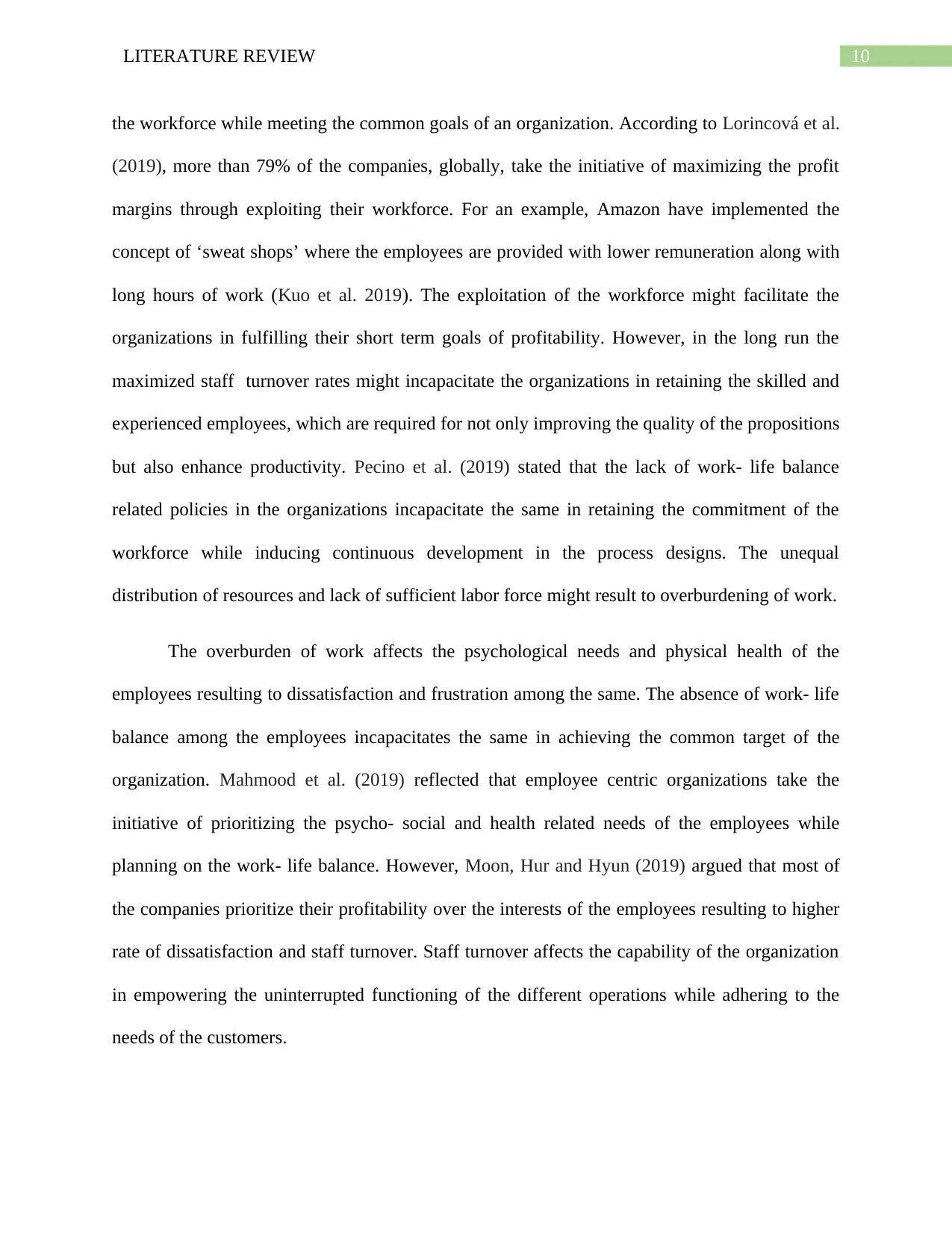
10LITERATURE REVIEW
the workforce while meeting the common goals of an organization. According to Lorincová et al.
(2019), more than 79% of the companies, globally, take the initiative of maximizing the profit
margins through exploiting their workforce. For an example, Amazon have implemented the
concept of ‘sweat shops’ where the employees are provided with lower remuneration along with
long hours of work (Kuo et al. 2019). The exploitation of the workforce might facilitate the
organizations in fulfilling their short term goals of profitability. However, in the long run the
maximized staff turnover rates might incapacitate the organizations in retaining the skilled and
experienced employees, which are required for not only improving the quality of the propositions
but also enhance productivity. Pecino et al. (2019) stated that the lack of work- life balance
related policies in the organizations incapacitate the same in retaining the commitment of the
workforce while inducing continuous development in the process designs. The unequal
distribution of resources and lack of sufficient labor force might result to overburdening of work.
The overburden of work affects the psychological needs and physical health of the
employees resulting to dissatisfaction and frustration among the same. The absence of work- life
balance among the employees incapacitates the same in achieving the common target of the
organization. Mahmood et al. (2019) reflected that employee centric organizations take the
initiative of prioritizing the psycho- social and health related needs of the employees while
planning on the work- life balance. However, Moon, Hur and Hyun (2019) argued that most of
the companies prioritize their profitability over the interests of the employees resulting to higher
rate of dissatisfaction and staff turnover. Staff turnover affects the capability of the organization
in empowering the uninterrupted functioning of the different operations while adhering to the
needs of the customers.
the workforce while meeting the common goals of an organization. According to Lorincová et al.
(2019), more than 79% of the companies, globally, take the initiative of maximizing the profit
margins through exploiting their workforce. For an example, Amazon have implemented the
concept of ‘sweat shops’ where the employees are provided with lower remuneration along with
long hours of work (Kuo et al. 2019). The exploitation of the workforce might facilitate the
organizations in fulfilling their short term goals of profitability. However, in the long run the
maximized staff turnover rates might incapacitate the organizations in retaining the skilled and
experienced employees, which are required for not only improving the quality of the propositions
but also enhance productivity. Pecino et al. (2019) stated that the lack of work- life balance
related policies in the organizations incapacitate the same in retaining the commitment of the
workforce while inducing continuous development in the process designs. The unequal
distribution of resources and lack of sufficient labor force might result to overburdening of work.
The overburden of work affects the psychological needs and physical health of the
employees resulting to dissatisfaction and frustration among the same. The absence of work- life
balance among the employees incapacitates the same in achieving the common target of the
organization. Mahmood et al. (2019) reflected that employee centric organizations take the
initiative of prioritizing the psycho- social and health related needs of the employees while
planning on the work- life balance. However, Moon, Hur and Hyun (2019) argued that most of
the companies prioritize their profitability over the interests of the employees resulting to higher
rate of dissatisfaction and staff turnover. Staff turnover affects the capability of the organization
in empowering the uninterrupted functioning of the different operations while adhering to the
needs of the customers.
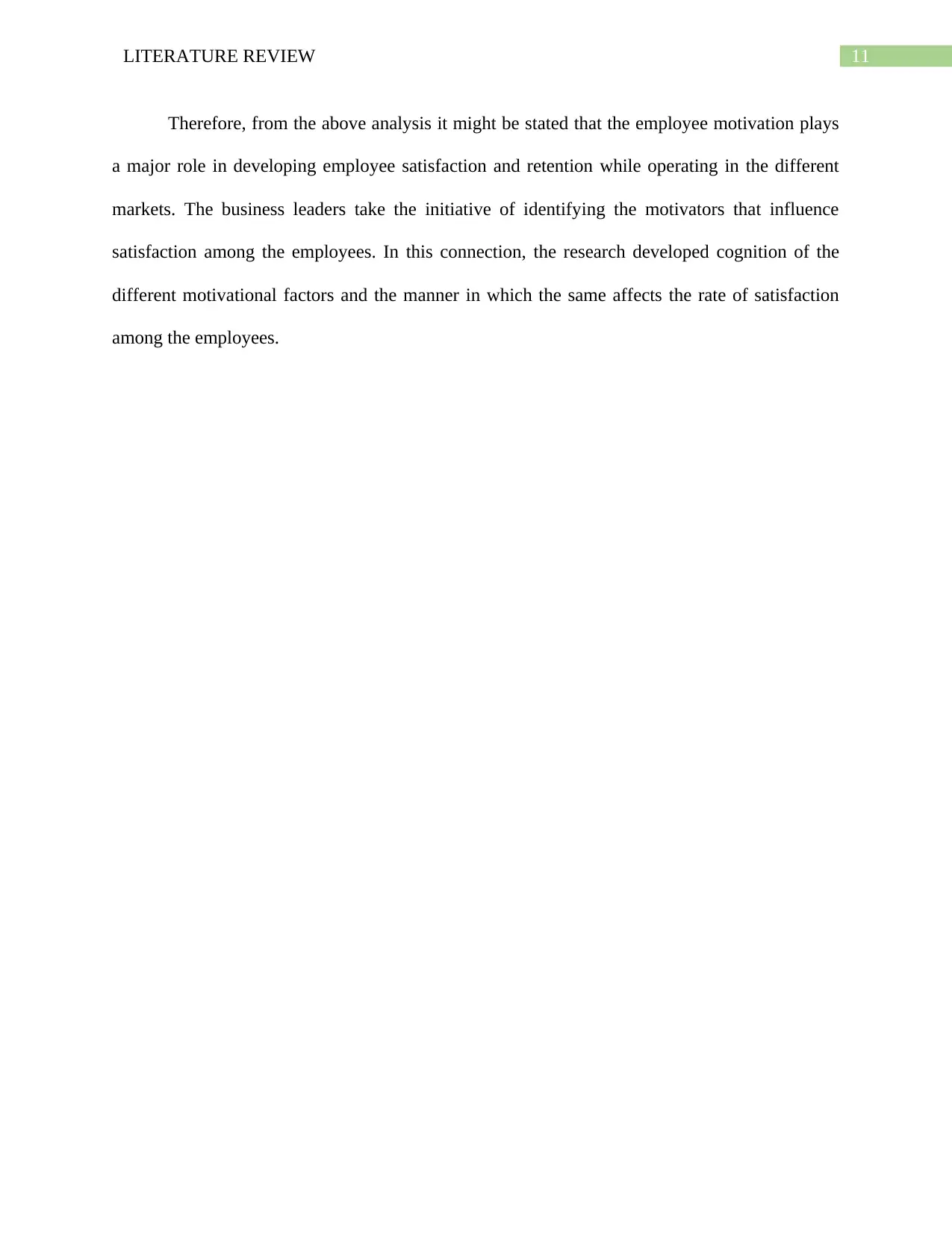
11LITERATURE REVIEW
Therefore, from the above analysis it might be stated that the employee motivation plays
a major role in developing employee satisfaction and retention while operating in the different
markets. The business leaders take the initiative of identifying the motivators that influence
satisfaction among the employees. In this connection, the research developed cognition of the
different motivational factors and the manner in which the same affects the rate of satisfaction
among the employees.
Therefore, from the above analysis it might be stated that the employee motivation plays
a major role in developing employee satisfaction and retention while operating in the different
markets. The business leaders take the initiative of identifying the motivators that influence
satisfaction among the employees. In this connection, the research developed cognition of the
different motivational factors and the manner in which the same affects the rate of satisfaction
among the employees.
⊘ This is a preview!⊘
Do you want full access?
Subscribe today to unlock all pages.

Trusted by 1+ million students worldwide
1 out of 16
Related Documents
Your All-in-One AI-Powered Toolkit for Academic Success.
+13062052269
info@desklib.com
Available 24*7 on WhatsApp / Email
![[object Object]](/_next/static/media/star-bottom.7253800d.svg)
Unlock your academic potential
Copyright © 2020–2025 A2Z Services. All Rights Reserved. Developed and managed by ZUCOL.




